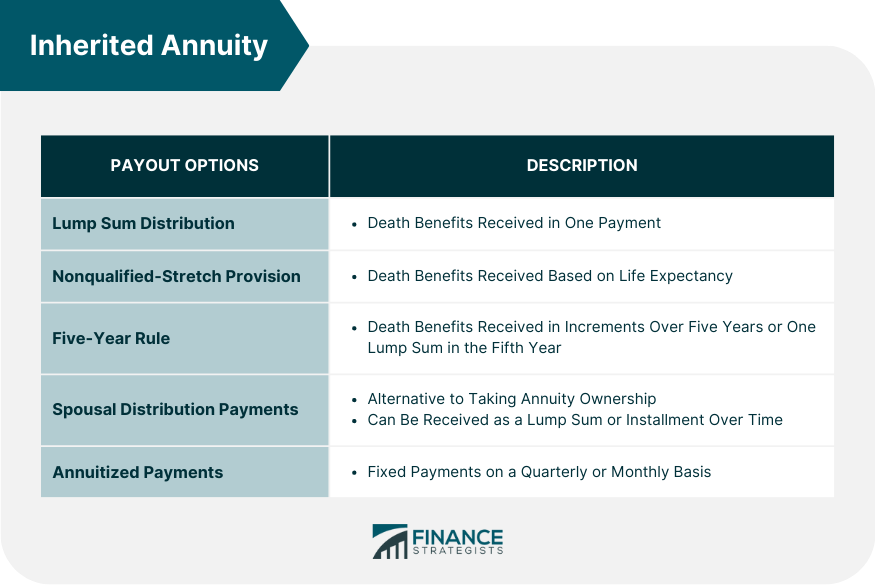All Categories
Featured
Table of Contents
This five-year general guideline and 2 adhering to exemptions use just when the proprietor's fatality activates the payout. Annuitant-driven payments are discussed listed below. The initial exemption to the general five-year guideline for specific beneficiaries is to approve the survivor benefit over a longer period, not to go beyond the anticipated life time of the beneficiary.
If the beneficiary chooses to take the death benefits in this technique, the advantages are tired like any type of other annuity settlements: partly as tax-free return of principal and partially gross income. The exemption proportion is found by making use of the departed contractholder's price basis and the expected payouts based on the recipient's life span (of shorter duration, if that is what the recipient picks).
In this approach, sometimes called a "stretch annuity", the recipient takes a withdrawal yearly-- the called for amount of yearly's withdrawal is based on the same tables utilized to compute the needed distributions from an individual retirement account. There are two advantages to this method. One, the account is not annuitized so the beneficiary retains control over the cash money worth in the agreement.
The second exception to the five-year policy is offered only to a surviving partner. If the marked beneficiary is the contractholder's partner, the partner may choose to "tip into the shoes" of the decedent. Essentially, the spouse is treated as if he or she were the proprietor of the annuity from its beginning.
Do you pay taxes on inherited Lifetime Annuities
Please note this applies just if the partner is named as a "assigned beneficiary"; it is not readily available, for example, if a trust is the beneficiary and the spouse is the trustee. The basic five-year regulation and both exceptions only put on owner-driven annuities, not annuitant-driven contracts. Annuitant-driven agreements will certainly pay fatality advantages when the annuitant passes away.

For functions of this conversation, think that the annuitant and the owner are different - Fixed annuities. If the agreement is annuitant-driven and the annuitant dies, the death triggers the survivor benefit and the beneficiary has 60 days to make a decision how to take the survivor benefit subject to the regards to the annuity contract
Also note that the option of a partner to "enter the footwear" of the proprietor will certainly not be offered-- that exemption uses only when the owner has died yet the owner didn't die in the circumstances, the annuitant did. Lastly, if the beneficiary is under age 59, the "fatality" exception to stay clear of the 10% penalty will certainly not put on an early distribution once again, since that is offered just on the death of the contractholder (not the fatality of the annuitant).
As a matter of fact, numerous annuity companies have internal underwriting policies that reject to issue agreements that name a various owner and annuitant. (There might be weird situations in which an annuitant-driven agreement satisfies a customers one-of-a-kind demands, however generally the tax obligation negative aspects will certainly exceed the advantages - Flexible premium annuities.) Jointly-owned annuities may posture comparable problems-- or at the very least they may not serve the estate preparation function that jointly-held possessions do
As a result, the fatality advantages should be paid out within five years of the first proprietor's fatality, or based on both exceptions (annuitization or spousal continuation). If an annuity is held collectively between a couple it would certainly show up that if one were to die, the various other can just continue possession under the spousal continuation exemption.
Think that the other half and other half called their child as beneficiary of their jointly-owned annuity. Upon the death of either proprietor, the firm needs to pay the fatality advantages to the child, who is the beneficiary, not the enduring partner and this would most likely defeat the owner's intentions. Was hoping there may be a system like establishing up a beneficiary Individual retirement account, yet looks like they is not the case when the estate is setup as a beneficiary.

That does not recognize the sort of account holding the acquired annuity. If the annuity remained in an inherited IRA annuity, you as executor should be able to appoint the inherited IRA annuities out of the estate to inherited IRAs for every estate beneficiary. This transfer is not a taxable occasion.
Any distributions made from acquired Individual retirement accounts after project are taxable to the recipient that received them at their ordinary earnings tax obligation price for the year of distributions. Yet if the acquired annuities were not in an individual retirement account at her fatality, then there is no chance to do a direct rollover right into an inherited IRA for either the estate or the estate beneficiaries.
If that happens, you can still pass the distribution with the estate to the individual estate beneficiaries. The earnings tax return for the estate (Kind 1041) could consist of Form K-1, passing the earnings from the estate to the estate beneficiaries to be exhausted at their individual tax rates as opposed to the much higher estate income tax prices.
Do beneficiaries pay taxes on inherited Long-term Annuities
:max_bytes(150000):strip_icc()/Death-taxes_sketch_final-422a2456bff64e4da2f9dabb41c64ad9.png)
: We will certainly create a strategy that consists of the very best products and attributes, such as boosted death benefits, premium benefits, and permanent life insurance.: Obtain a personalized approach made to optimize your estate's worth and decrease tax liabilities.: Carry out the selected strategy and obtain ongoing support.: We will assist you with establishing the annuities and life insurance policy policies, giving constant support to guarantee the strategy stays reliable.
Ought to the inheritance be related to as an income related to a decedent, after that tax obligations may use. Generally talking, no. With exception to pension (such as a 401(k), 403(b), or individual retirement account), life insurance proceeds, and savings bond rate of interest, the recipient typically will not have to birth any income tax on their acquired wide range.
The quantity one can inherit from a trust fund without paying tax obligations depends on different elements. Specific states might have their very own estate tax obligation guidelines.

His objective is to simplify retirement planning and insurance coverage, ensuring that customers understand their options and protect the most effective protection at unsurpassable rates. Shawn is the owner of The Annuity Professional, an independent on the internet insurance coverage firm servicing customers across the United States. Through this system, he and his group goal to eliminate the guesswork in retired life preparation by assisting people find the most effective insurance protection at the most competitive rates.
Table of Contents
Latest Posts
Highlighting the Key Features of Long-Term Investments A Comprehensive Guide to Investment Choices Defining Choosing Between Fixed Annuity And Variable Annuity Features of Smart Investment Choices Why
Understanding Financial Strategies A Comprehensive Guide to Investment Choices What Is the Best Retirement Option? Benefits of Immediate Fixed Annuity Vs Variable Annuity Why Choosing the Right Financ
Understanding Variable Annuity Vs Fixed Annuity Everything You Need to Know About Financial Strategies Defining Annuities Variable Vs Fixed Advantages and Disadvantages of Different Retirement Plans W
More
Latest Posts